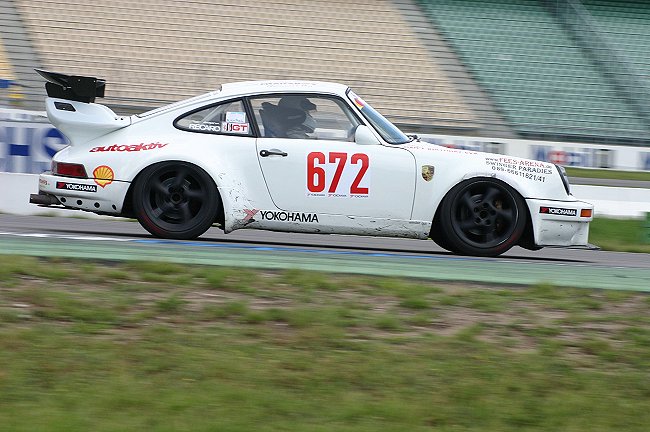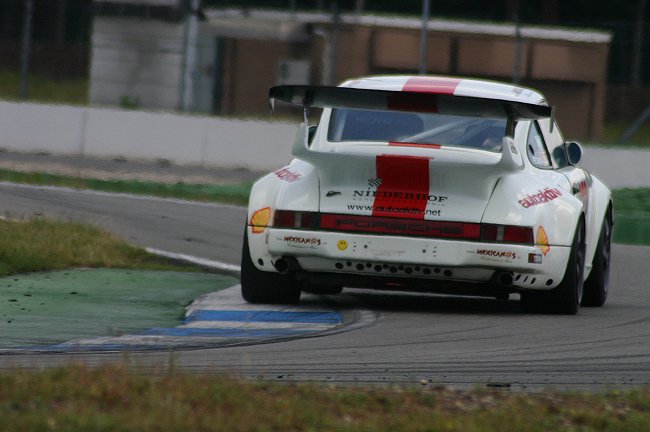PTA Planes, Trains & Automobiles
Gemotoriseerd of niet, alles op wielen heeft hier een plek. Van oldtimers tot je nieuwe fiets, van Smart tot brandweerwagen, post het hier!



De OP
Since producing a handful of Group B spec 911 Turbo's during the early eighties, Porsche had been without a customer GT racing car. This was largely due to the lack of any high calibre championships being organised for anything other than sports prototypes, but that was all to change in the early nineties after the demise of Group C. GT racing subsequently underwent something of a renaissance and was soon back to its best with packed grids of Ferrari's, Porsche's, McLaren's, Lotus and Jaguar's competing in a variety of high profile events from Europe to South America.
At the centre was the new BPR Championship that kicked off in 1994, other series like the ADAC league in Germany also being set up specifically for production-style racing cars. Where sports racing cars were still allowed to run, like at the Le Mans 24 Hours and IMSA in the States, GT's were handed concessions that led to a more even playing field. However, although there was a good degree of common ground between the various arenas now open to GT's, because they were all organised by different sanctioning bodies, the rules demanded a certain flexibility by manufacturers with regard to weight and power. Regardless, with several of Porsche's biggest rivals preparing new cars, the German firm were obliged to build a 911-based hot rod from which a racer could be derived. That car was the 3.8-litre Carrera RS and those customers who wanted do battle on the track merely had to specifiy the RSR option. This included a racing chassis with fully adjustable Bilstein shock absorbers and a braking system from the Turbo S with re-tuned ABS and competition brake pads. There were also cockpit adjustable anti-roll bars and three-piece light-alloy wheels that were half-an-inch wider all round. At 9.5-inches front and 11.5 at the rear, the wheels were originally shod with Pirelli slicks.
The engine was equipped with racing camshafts and output varied from between 325bhp at 6900rpm to 375bhp at 7400rpm. This depended on which series was being contested and output was regulated by air restrictors of varying sizes. Each RSR was also fitted with a supplementary oil radiator and 120-litre FT3 fuel tank. A five-speed manual gearbox with competition clutch was initially used although a six-speed unit derived from the 993 became standard from September of 1993 after around a dozen had been completed. Externally, composite panels were used for the sills and bumpers whilst the engine cover, doors and latched front front lid were all aluminium. Like the 3.8 RS, there were air intakes positioned next to the front indicators and a jutting chin spoiler, the plastic dual plane rear wing having been fully adjustable. Extra front lights could be specified, these being incorporated into the centre of the front bumper where a number plate would normally reside on a street car. The interior was comprehensively stripped of all soundproofing material and any superfluous trim, Porsche installing a solitary Recaro bucket seat with six-point harness, a roll cage and a complete fire protection system. Weighing in at 1215kg, ballast was applied where necessary to bring the RSR up the minimum weight of any given rulebook. Top speed was 181mph and 0-60 took just 4.7 seconds. Production ran between April 1993 and September '94, 45 3.8 RSR's eventually being completed.
vorige deeltjes
http://ptaslowchat.tk
De code voor de op is hier te vinden
Chat on


televisiepost
Return of the Unox-muts
Bezitter van een burgerbak Voorheen Alfist
verrekte koekwaus :')
Pappa van Aafke en Onno
Bezitter van een burgerbak Voorheen Alfist
verrekte koekwaus :')
Pappa van Aafke en Onno


Porsche
Alle hoeren kunnen vertrekken, zolang de man nog z'n handen heeft om zelf te kunnen trekken.
Never underestimate the power of stupid people in a large group
Never underestimate the power of stupid people in a large group


idd, kijk dit filmpje maar eens!!quote:
http://video.google.com/videoplay?docid=1294420330942974226&q=porsche


ik wil nog steets een ouwe porsche hebben met 2 kuipstoelen en open uitlaat systeem. Niks geen dempers meer. Gewoon puur race uitvoering. Rol beugel er in. En scheuren met die hap. En als ik hem start of als ik aan her rijden ben moet er een geluid uit komen waar je bang van word
Alle hoeren kunnen vertrekken, zolang de man nog z'n handen heeft om zelf te kunnen trekken.
Never underestimate the power of stupid people in a large group
Never underestimate the power of stupid people in a large group


Die plaatjes zijn nevernooitniet van een 964, check de achterlichten.
Verder kom ik nooit in PTA SC; dus houdoe maar weer
Goed topic verder
Verder kom ik nooit in PTA SC; dus houdoe maar weer
Goed topic verder
How do we turn this world-class fuck-up into a world-class learning experience?


deze post moet je ergens in een word doc hebben staan want die heb ik nou al 56x voorbij zien komenquote:Op zondag 4 december 2005 17:13 schreef ook_gek het volgende:
ik wil nog steets een ouwe porsche hebben met 2 kuipstoelen en open uitlaat systeem. Niks geen dempers meer. Gewoon puur race uitvoering. Rol beugel er in. En scheuren met die hap. En als ik hem start of als ik aan her rijden ben moet er een geluid uit komen waar je bang van word


Bo voor jou een leuke auto gevonden
Leuk voor jou toch
¤ 3.950quote:Mitsubishi Colt rally uitvoering, 1992 volledige rolkooi, kuipstoelen, Mivec motor, onsteking via computer te
Leuk voor jou toch
Alle hoeren kunnen vertrekken, zolang de man nog z'n handen heeft om zelf te kunnen trekken.
Never underestimate the power of stupid people in a large group
Never underestimate the power of stupid people in a large group


een japquote:Op zondag 4 december 2005 17:15 schreef ook_gek het volgende:
Bo voor jou een leuke auto gevonden
[afbeelding]
[..]
¤ 3.950
Leuk voor jou toch


Nee ben goed in onthoudenquote:Op zondag 4 december 2005 17:14 schreef BoJo het volgende:
[..]
deze post moet je ergens in een word doc hebben staan want die heb ik nou al 56x voorbij zien komen
http://www.vankesselporsche.com/photo22.htm Leuke auto voor mij
Alle hoeren kunnen vertrekken, zolang de man nog z'n handen heeft om zelf te kunnen trekken.
Never underestimate the power of stupid people in a large group
Never underestimate the power of stupid people in a large group


Mja en je dan helemaal ziek betalen aan onderhoud
En lekker zonder comfort
En lekker zonder comfort
** Die nacht ist vorbei, ein neuer Tag beginnt. Alles sprung. Stadtkind. Berlin. **


Ja maar hij trekt wel elke auto er uit denk ik zoquote:
http://www.vankesselporsche.com/photo31.htm
Meer foto's
Alle hoeren kunnen vertrekken, zolang de man nog z'n handen heeft om zelf te kunnen trekken.
Never underestimate the power of stupid people in a large group
Never underestimate the power of stupid people in a large group


ik vind deze wel leuk http://www.vankesselporsche.com/photo5.htmquote:Op zondag 4 december 2005 17:16 schreef ook_gek het volgende:
[..]
Nee ben goed in onthouden
http://www.vankesselporsche.com/photo22.htm Leuke auto voor mij


quote:Op zondag 4 december 2005 17:18 schreef Alfisti het volgende:
mee-lurkt
nu moet ik oppassen met wat ik zeg


is ook leuk jaquote:Op zondag 4 december 2005 17:19 schreef BoJo het volgende:
[..]
ik vind deze wel leuk http://www.vankesselporsche.com/photo5.htm
het is dat ik nog even geen geld heb
Maar als ik wat meer geld heb en ook geld over heb ga ik echt van die debielen dingen kopen
Alle hoeren kunnen vertrekken, zolang de man nog z'n handen heeft om zelf te kunnen trekken.
Never underestimate the power of stupid people in a large group
Never underestimate the power of stupid people in a large group


quote:Op zondag 4 december 2005 17:20 schreef Alfisti het volgende:
[..]
* Alfisti zoekt snel door oude SC's heen
nee ik heb mijn mind set to een speciale Alfa hoor








